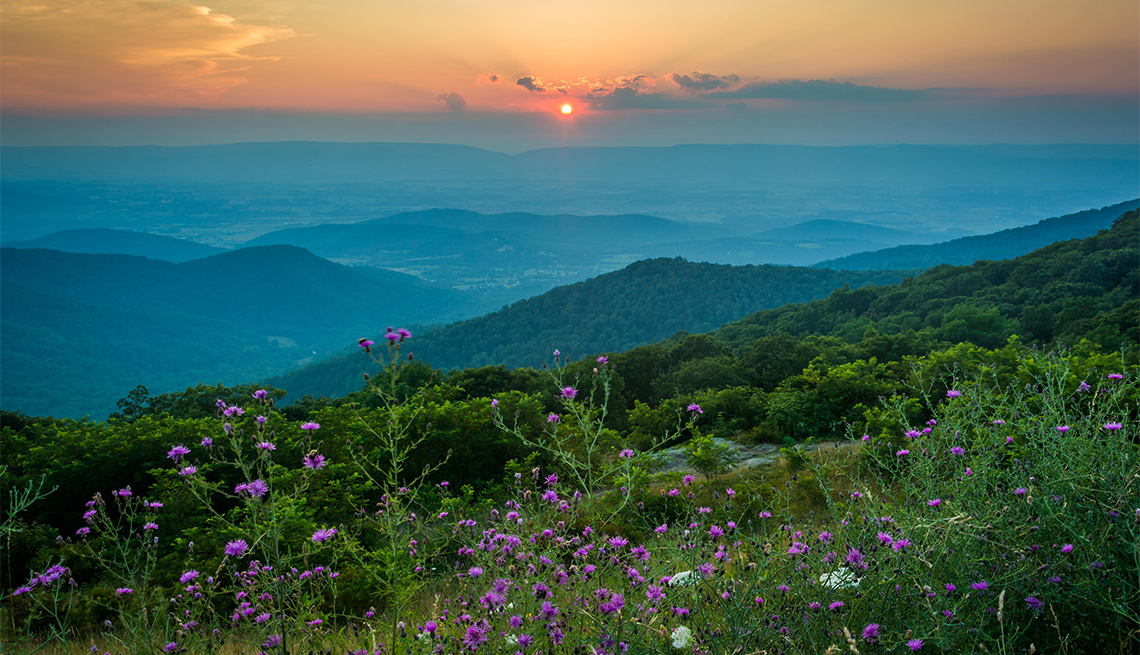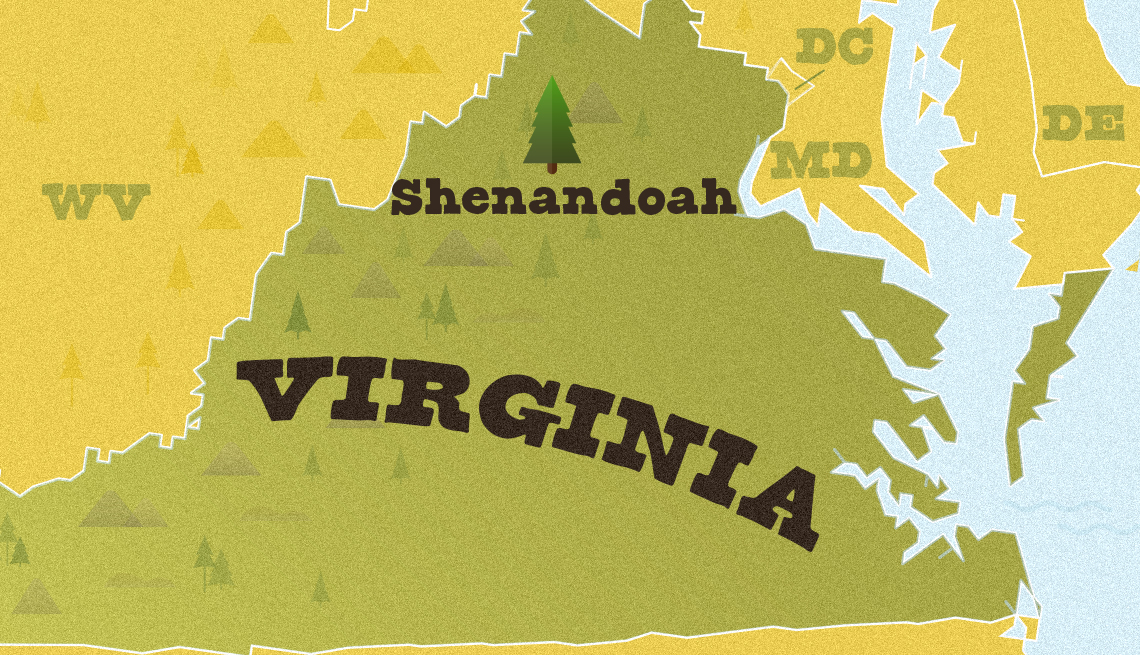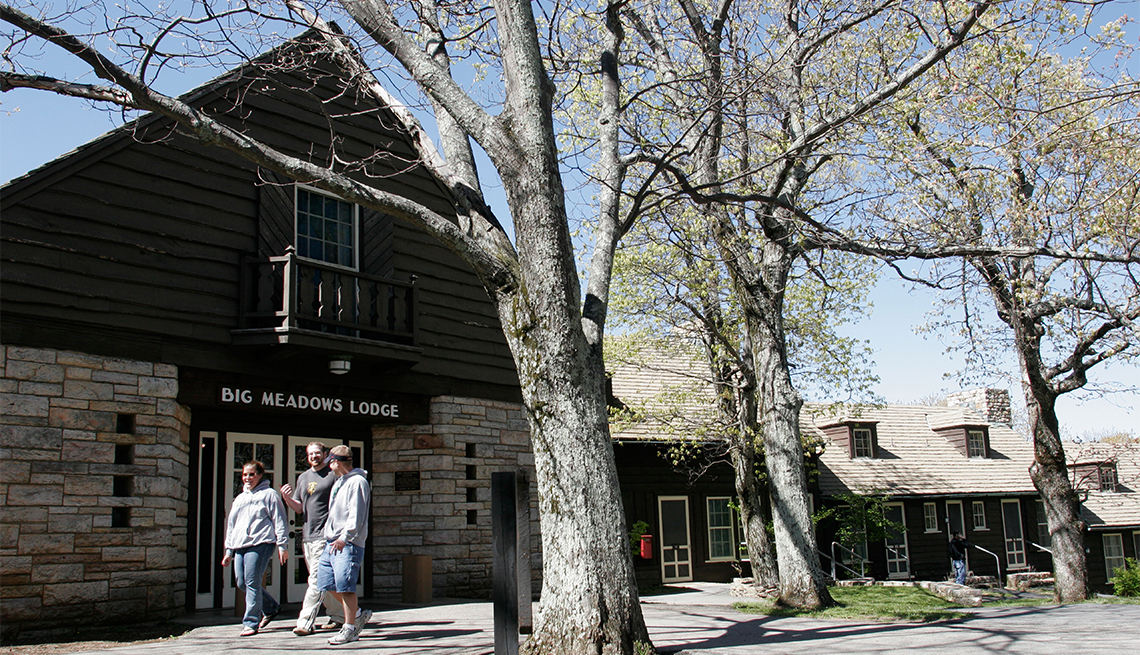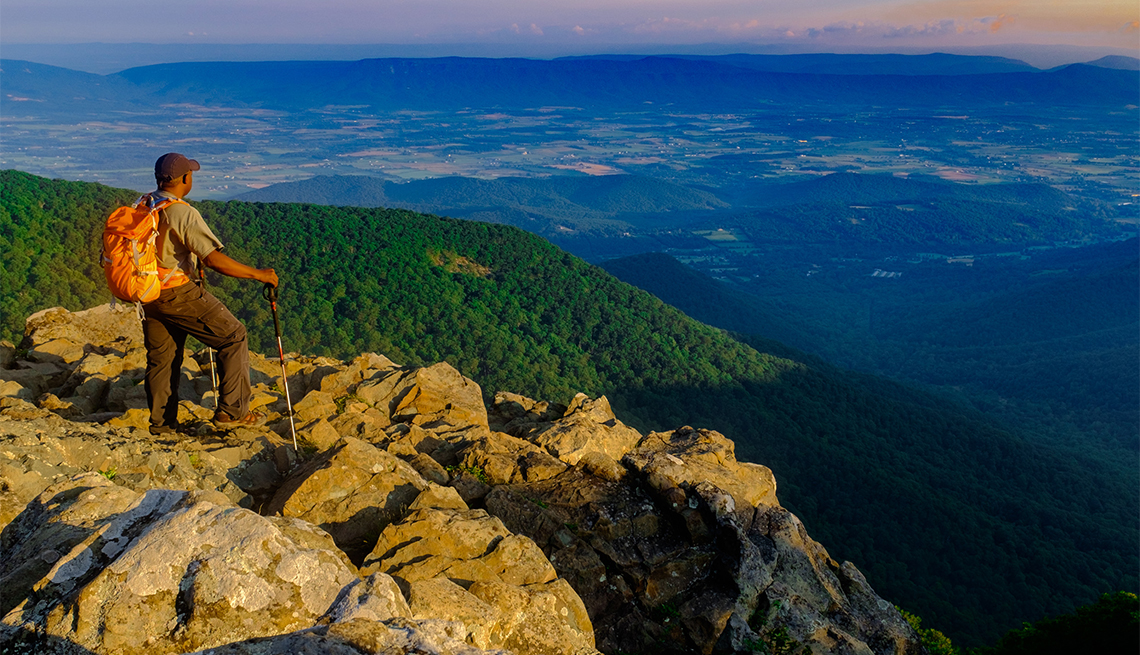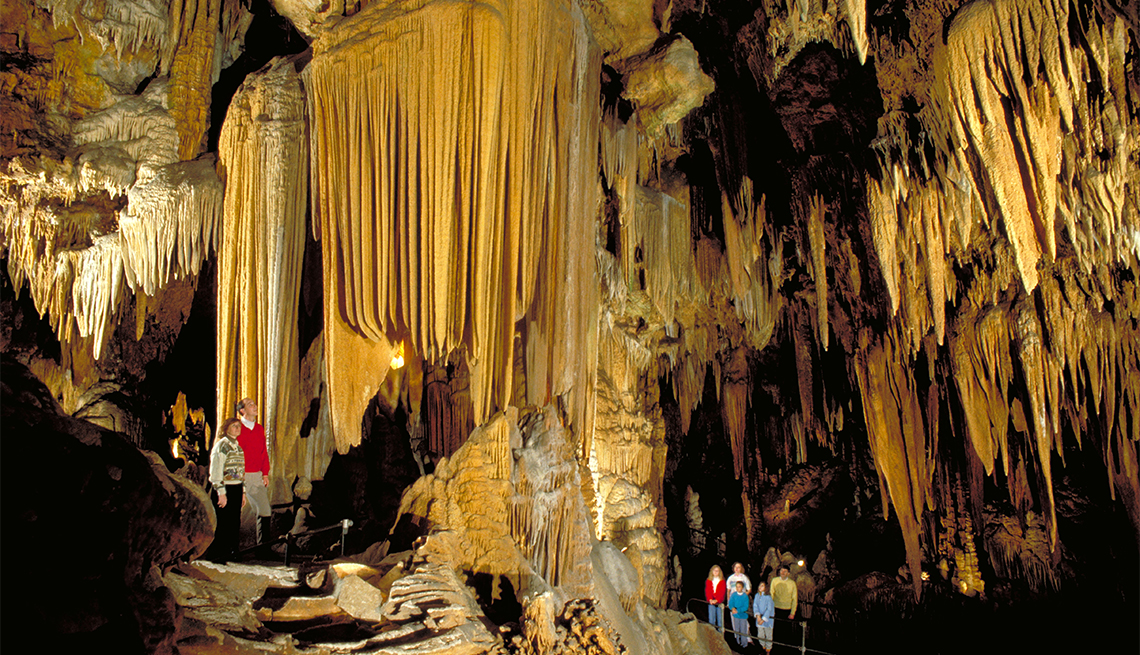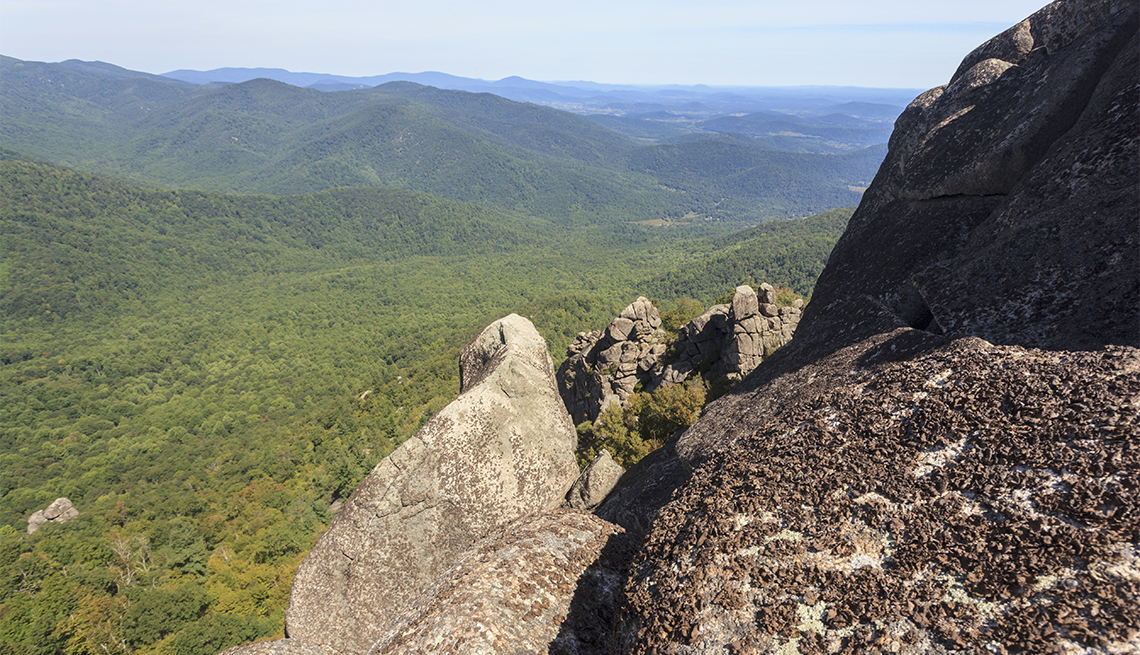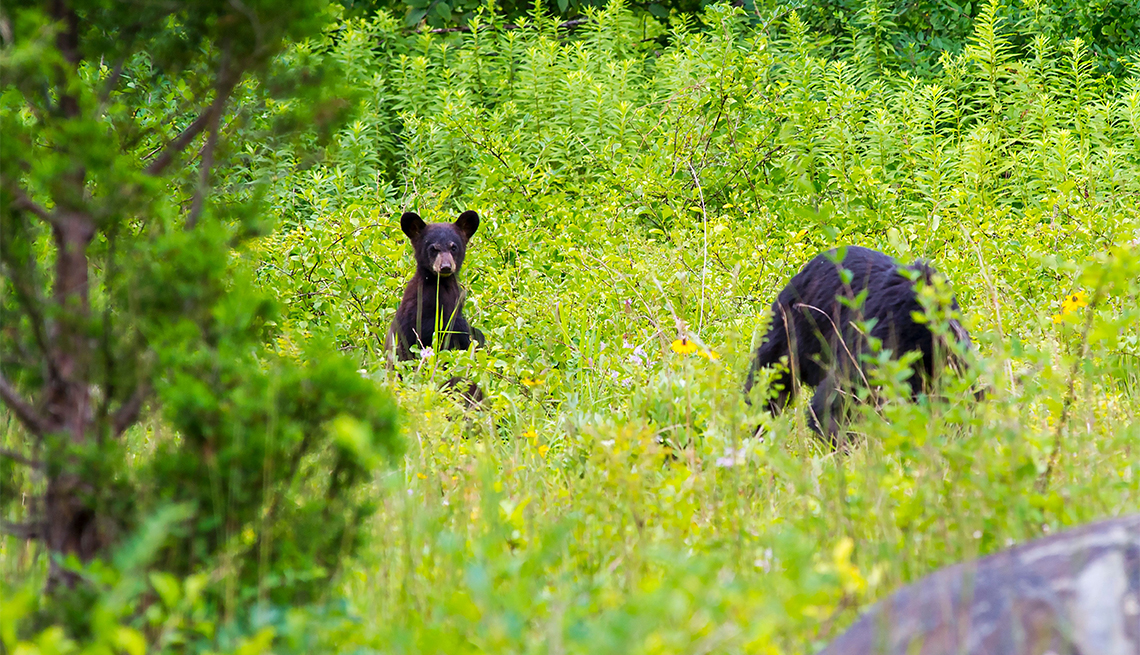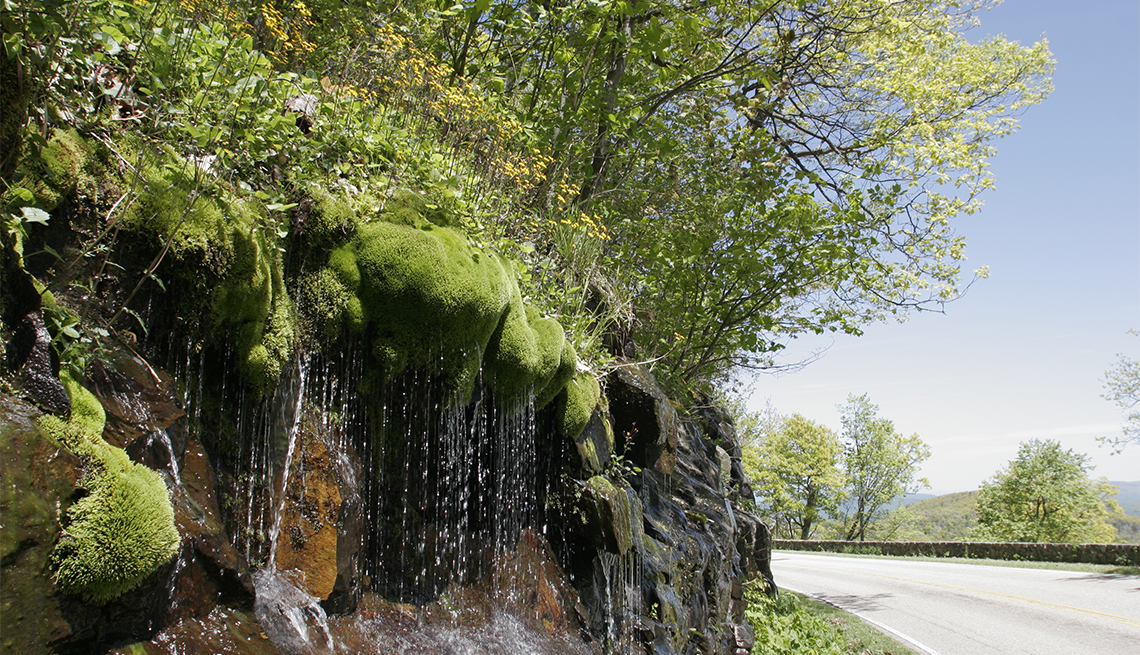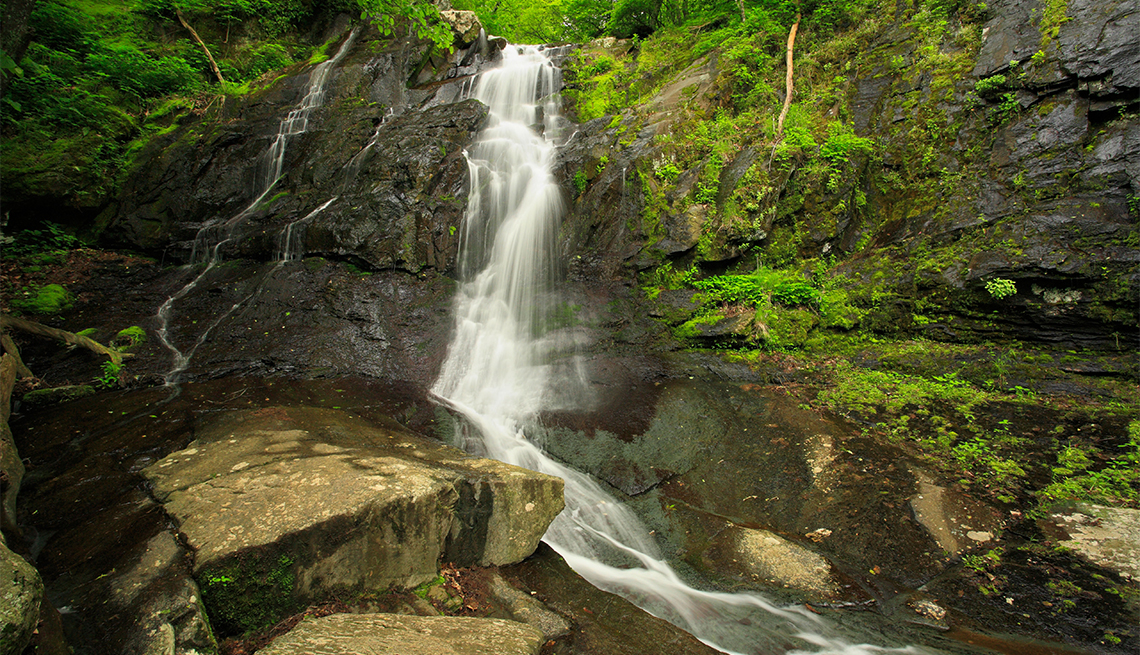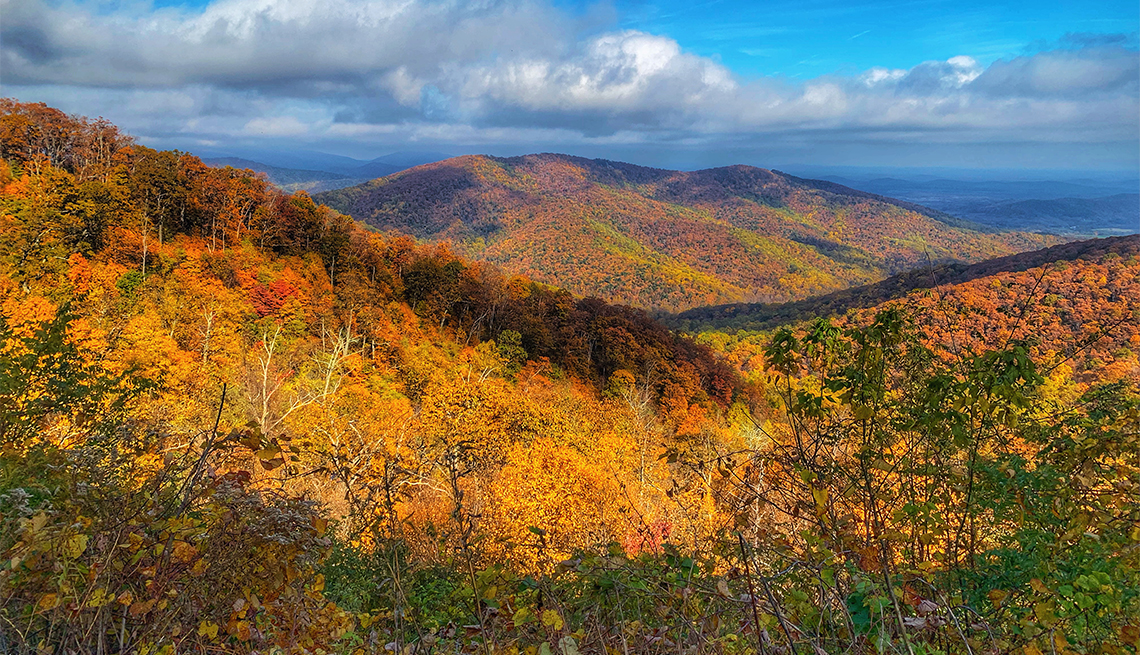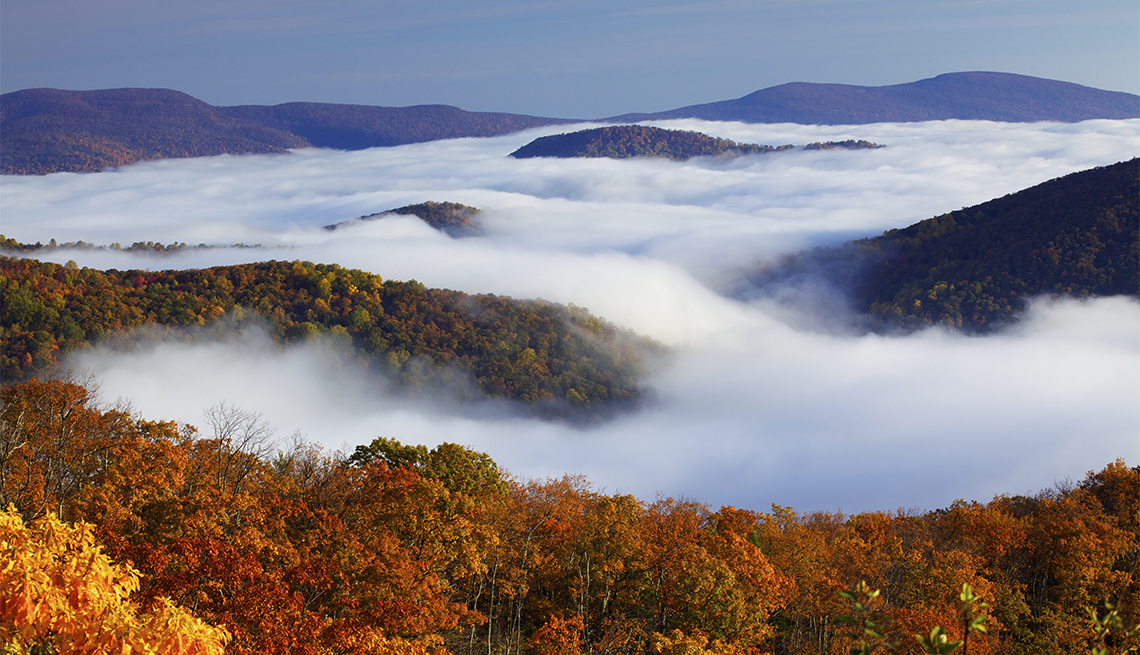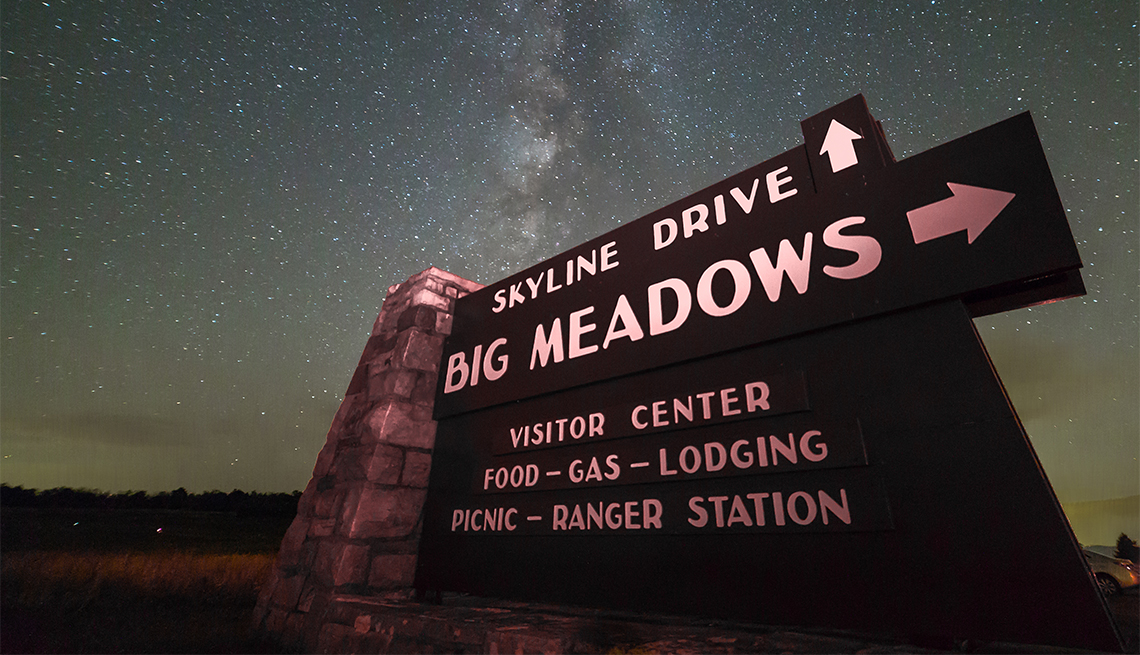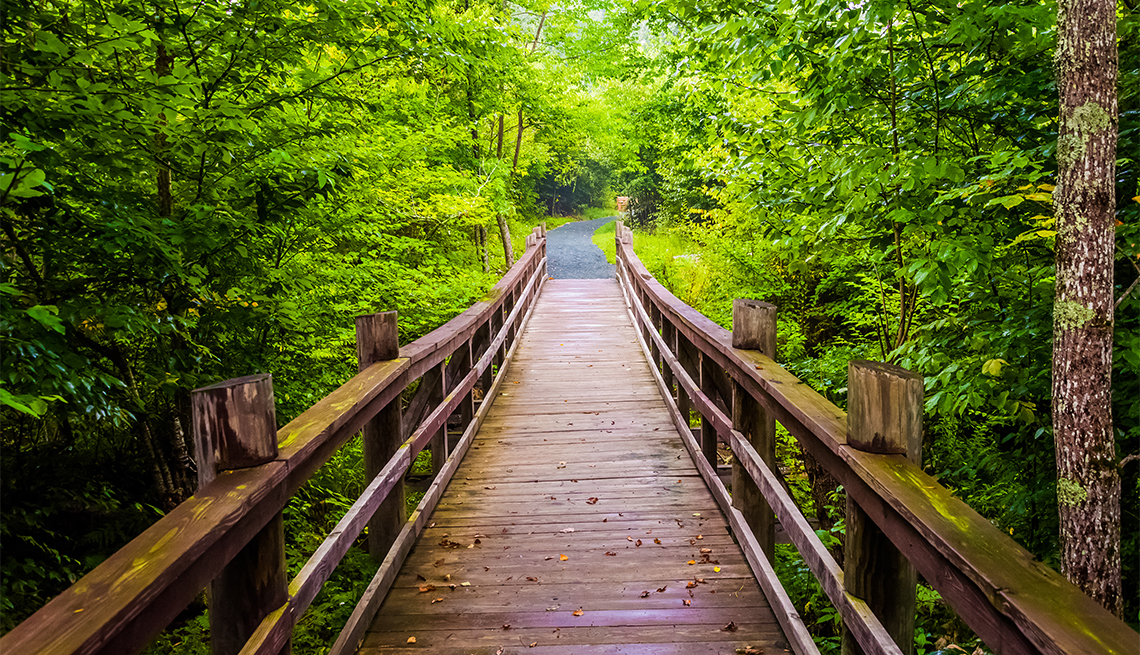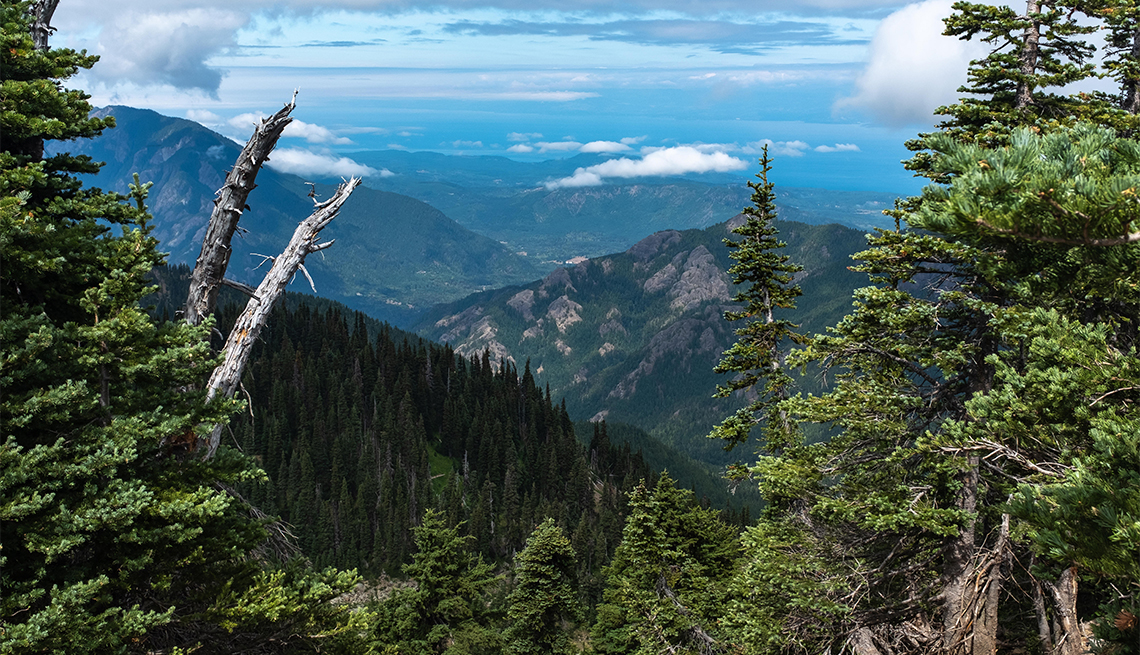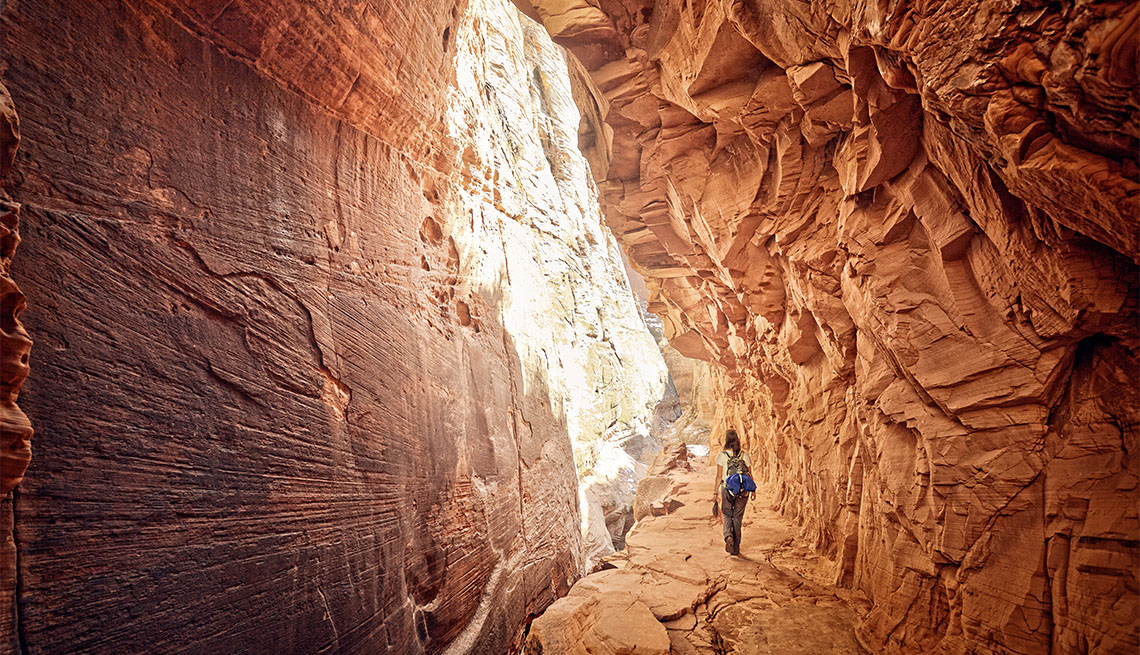AARP's Guide to Shenandoah National Park
Cruise scenic Skyline Drive, explore mountain trails and find serenity at this Virginia treasure
En español | Gushing waterfalls. Rolling mountains. Granite peaks. Lush valleys. Ninety-plus streams. Fog oceans that tumble over the Blue Ridge Mountains. Animals and wildflowers aplenty. With such an abundance of natural beauty, Shenandoah National Park (SNP) ranks as one of Virginia's wildest yet most serene destinations. Author Bill Bryson calls it “possibly the most wonderful national park I have ever been in."
Native Americans wandered this area for millennia to hunt, gather food and collect materials for stone tools ("Shenandoah” is a Native American word that some historians believe means “daughter of the stars"). European hunters and trappers arrived in the 1700s, followed by settlers and entrepreneurs who launched farming, logging, milling and mining operations. In the early 1900s, inspired by the popularity of Western national parks, Virginia politicians and businessmen pushed for a park in the East, and President Calvin Coolidge signed legislation authorizing SNP in 1926. Roughly 465 families had to leave their homes after the state of Virginia acquired the land, but a few stubborn mountaineers refused to go, living the rest of their lives in the thick woods.
In 1931, the federal highway department began building SNP's signature attraction, 105-mile Skyline Drive, which runs north to south through the length of the park. Two years later, the Civilian Conservation Corps — one of President Franklin D. Roosevelt's pet New Deal programs — started constructing its infrastructure, from overlooks to picnic areas, and FDR dedicated the 197,438 acre park in 1936. Fast forward to 2020, and this Old Dominion beauty now attracts 1.4 million visitors annually.
Location: Virginia, about 75 miles southwest of Washington, D.C.
Acreage: 197,438 acres
Highest peak: Hawksbill, at 4,051 feet
Miles/number of trails: 518 miles along 335 trails
Main attraction: Skyline Drive
Entry fee: $30 per vehicle (annual Senior Pass $20)
Best way to see it: By car and by foot
When to go to avoid the crowds: December through March
Plan Your Trip
From Washington, D.C., SNP is an easy 71-mile drive southwest. It's also a doable drive from Philadelphia (210 miles northwest of the park) and Raleigh, North Carolina (218 miles south). Prefer flying? Two major D.C.-area airports in Virginia are nearby: Dulles International (56 miles northeast) and Reagan National (70 miles northeast) in Arlington. A compact-car rental will work fine on Shenandoah's well-paved roads.
In the park, mileposts along Skyline Drive will help you locate significant sites, from lodges to trailheads. The Dickey Ridge Visitor Center is at mile 4.6, for example; the Harry F. Byrd Sr. Visitor Center, mile 51. The numbering system starts in the north at the Front Royal entrance (mile 0) and ends at the southern Rockfish Gap entrance (mile 105). Two middle entrances are Thornton Gap (mile 31.5) and Swift Run Gap (mile 65.7). The entrance fee is $30 per vehicle (annual Senior Pass, $20).
In October, the most-visited month, throngs of leaf lovers arrive for fall foliage, but autumn's reds and golds are worth the extra traffic and overflowing parking lots on Skyline Drive. Come on a weekday for smaller crowds. The leaves change sooner at higher elevations, so explore the park's lower points between the Front Royal and Thornton Gap entrances if you go later in October. The park website posts a frequently updated report on when the leaves will hit their peak colors. Don't count on posting foliage photos on social media while in the park. Cellphone service is spotty at best, though the two lodges and visitors centers offer Wi-Fi.
You'll see stunning sights any season you visit. May brings woodland flowers such as trillium, which grows near streambanks and other wet areas. Columbine, milkweed and other wildflowers take the floral stage in June; black-eyed Susans and goldenrods often bloom into fall. Other seasonal draws: Waterfalls are typically fullest in spring and fall, and some park visitors favor the quiet of winter. Sure, it's cold — average high temperatures in the mid to upper 30s — but you'll experience the park in a completely different way.
"You'll see deeper into the woods in winter because there's nothing obstructing your view,” says Sally Hurlbert, management specialist and a former 20-year SNP ranger. “You'll see more of the rock outcrops and you might see more deer because they're not blocked by the vegetation. And the lighting in the wintertime is beautiful."
December through March are the least-visited months — the facilities are closed then, so bring food and plenty of water — and May and September tend to be quieter as well. Summer can be hot and humid (this is Virginia), but July's average high temperature is a comfy 75 — and Shenandoah is typically up to 10 degrees cooler than muggy D.C.
Restrooms are available at the park's picnic grounds (some are pit toilets), visitors centers, lodges, waysides and camp stores. You'll find portable toilets at the Panorama Comfort Station (mile 31.6) and at the Beagle Gap parking area (mile 99.5).
Where to Stay and Eat
Some national parks have iconic hotels worth seeing even if you're not a guest, but SNP's two lodges are pleasant places to stay, not must-see attractions, each offering a mix of rooms, cabins, multiunit lodges and suites. Their advantage over gateway-town hotels: The lodges and the park's cabins and campgrounds are within easy walking distance of trails and you can revel in Shenandoah's quiet, woodsy seclusion.
Big Meadows Lodge (mile 51), near the Byrd Visitor Center, was built in 1939 using local chestnut trees and stones from nearby Massanutten Mountain. From the lodge's wood-paneled lobby, enjoy the sweeping view of 30-mile-wide Page Valley. Walk just a mile at sunset to Big Meadows, the park's largest meadow, and you'll see whitetail deer grazing; in August, you might spot bears dining on blueberries. The lodge is open from early May through early November.
If you book the Skyland lodge (mile 41.7), request a room with a balcony overlooking Massanutten Mountain and Page Valley. With Skyland's elevation at 3,680 feet, Skyline Drive's highest point, you'll get jaw-dropping views. The property is open April through November.
For something only slightly more rustic, settle into a cabin in the dense woods at Lewis Mountain Cabins (mile 57.5) — no Wi-Fi, air-conditioning or kitchen, but you'll have a bathroom, electricity and an outdoor grill. Rentals from April through November.
Whichever option you choose, book at least three to four weeks in advance for spring and summer, and 10 to 12 months ahead for fall-foliage season.
SNP's five campgrounds — spread out along Skyline Drive in secluded, tree-filled locales — open at different times between March and May, and then close in fall. Driving an RV? Stay at Mathews Arm (mile 22.2), Big Meadows (mile 51.2) or Loft Mountain (mile 79.5). For showers and washing machines, choose Big Meadows or Loft Mountain. Dundo (mile 83.7) is for groups of seven to 15 people.
Lewis Mountain (mile 57.5) is exclusively first come, first served; the other campgrounds accept reservations while also offering limited spots on a first-come, first-served basis. Nightly permits range from $15 to $50. Book up to six months in advance at recreation.gov or by calling 877-444-6777.
Ready for some Virginia cuisine? At Big Meadows Lodge, the Spottswood Dining Room serves Southern favorites such as fried chicken, along with wow-inducing views of Page Valley on the pet-friendly terrace. Skyland's Pollock Dining Room also mixes regional dishes with valley views. The must-try dessert at both restaurants: blackberry ice cream pie.
Seven shady picnic grounds lie between miles 4.6 and 83.7, tucked away from Skyline Drive noise. Overlooks make appealing picnic spots, too. Or walk to easy-to-reach summits, such as the 1.6-mile round-trip Stony Man trail (mile 41.7). Sit on a rock, eat your PB&J and gaze out at the mountains and valley. If you didn't pack a lunch, the wayside food stops located every 25 miles on Skyline Drive sell carryout meals, groceries and camping supplies. Or stop by Addie's Corner at Skyland for sandwiches, pastries, beverages and snacks.
Things to Do
Driving: Cruising Skyline Drive to see the sights — that is SNP's must-do activity. The speed limit is only 35 mph, but you won't want to zoom past the gorgeous scenery. Whether you drive all 105 miles or just one lovely, leafy portion, stop for the panoramic views at some of the 75 overlooks. Two recommended by park staffers: the Big Run (mile 81.2) and Range View (mile 17.1). “On a clear day, you see ridge after ridge after bluish ridge,” says Hurlbert of Range View. “And you don't see a lot of development when you look down into the lowlands below. The same thing with Big Run — it's all wilderness."
Hiking: For all of Skyline Drive's two-laned delights, hiking is the best way to experience SNP's sights, sounds and smells — take your pick from 335 trails (including 101 miles of the Appalachian Trail). Park elevation peaks at about 4,000 feet, so even the steepest hikes aren't as daunting as their Western counterparts.
The 2.4-mile round-trip Compton Gap trail (mile 10.4) takes you on the Appalachian Trail to a T-like intersection. Go right and walk 0.2 miles for splendid views of the Blue Ridge Mountains. Go left 0.2 miles to a unique geologic formation: clumps of polygonal columns formed by ancient lava flows. The path is steep but worth the walk.
If you have accessibility issues, set out on the flat-and-mild, 1.3-mile Limberlost (mile 43), the park's only wheelchair-friendly trail. Rest on its benches and enjoy mountain laurels and bird calls. (Listen for towhees — the distinctive call sounds like, “Drink your teeee. Drink your teeee.") Nearby streams and plentiful food, such as apple trees, attract black bears, too. SNP rangers advise making noise so bears know you're nearby — they'll usually run from humans — and staying at least 150 feet away if you see any. The bears are not aggressive, but do not approach a mama with her cubs.
Waterfalls are among the park's most soul-soothing sites. Winding streams, hovering trees, crashing water — what's not to like? The moderate Whiteoak Canyon Trail (mile 42.6) features two falls, but to reduce fatigue, hike 4.6 miles round trip to the spectacular first falls — the Upper Whiteoak Falls — rather than walking to both. The reason: The trail descends (as do all the park's waterfall trails), so you endure the steep part on the way back. Before reaching the falls, side trails lead to a stream where you can walk on flat rocks, hear the thunderous rapids and feel cool air emanating from the water.
Hard-core hikers favor Old Rag, a strenuous 9.2-mile round-trip hike up Old Rag Mountain. Its multiple heart-pumping highlights include a rock scramble (you'll be clambering over rock faces, often using your hands for balance) and a summit. Tackle it on a weekday; this popular hike gets crowded on weekends, when you may even experience lines at narrow passages, which can feel more like a day at the DMV than a national park. You can't access Old Rag from Skyline Drive; rather, you'll need to take route 600. For directions to the trailhead, type in the address of Old Rag's newest parking lot — 2923 Nethers Road — into any mapping app.
Stargazing: Amateur astronomers often host night sky presentations, discussing celestial wonders and pointing out notable planets and stars. They typically set up telescopes on Rapidan Fire Road leading into Big Meadows, near the lodge. You can also attend a free outdoor “Under the Stars at Shenandoah National Park” presentation held monthly at the Big Meadows or Skyland lodges (time varies based on sunset). Talk topics range from meteorites to star life cycles. Each August, the park hosts Night Sky Festival, a weekend with presentations from rangers, astronauts and guest speakers on interstellar subjects.
Bird-watching, horseback riding, fishing: Prefer animals over Alpha Centauri? If you're a bird lover, meet an owl, raptor and a red-tailed hawk in the ranger-led Birds of Prey program, held four times a week at the amphitheater in the Big Meadows picnic ground (mile 51.2). Equestrians clip-clop across 200 miles of horse trails. Skyland Stables (mile 42.5) offers guided horseback and pony rides throughout the day. Anglers can cast in more than 70 streams with 38 species of fish, from brook trout to fantail darters.
Touring: Thanks to fishing, SNP can claim Herbert Hoover slept here. Frequently. In 1929, the then-president bought 164 acres for Rapidan Camp, near Skyline Drive's midpoint, as his personal fishing hideaway, welcoming big-shot guests such as Thomas Edison and Charles Lindbergh. The camp sits near two streams that merge to form the Rapidan River, surrounded by hemlocks. Make reservations online for a 2.5-hour ranger-led tour of the property and Hoover's wood cabin, named the Brown House to distinguish it from the White House. The simple-but-pretty interior has been restored to its 1929 appearance with much of the furniture original, although replica handmade Navajo rugs are most striking. Ride a minibus from the Byrd Visitor Center to get there, or hike 4 miles round trip from the Milam Gap parking area (mile 52.4).
Gateway Towns
Front Royal: Download a walking tour from the local visitors center to take in the must-see sites in this town 1 mile from SNP's north gate. Its charming historic district teems with antique shops, restaurants and attractions such as Belle Boyd Cottage (a tour reveals sizzling stories about Belle, one of the Confederacy's most infamous spies). Drop into Spelunker's for its frozen custard and burger, which a Washington Post food writer declared a culinary masterpiece. Stay at the nearby L'Auberge Provençale, named one of the world's 50 best romantic getaways in 2020 by Travel + Leisure. Rooms at the 270-year-old home in White Post (13 miles northeast of Front Royal) start at $180 a night, but the fresh croissants, French antiques and Provençale designs make the inn worth the splurge.
Waynesboro: Here, just 5 miles from the southern Rockfish Gap entrance, you'll find some of Virginia's best trout fishing as well as canoeing and kayaking on the 4-mile Waynesboro Water Trail. At the town's annual Virginia Street Arts Festival, artists paint large murals on buildings. From the patio at the Basic City Beer Co. take in a back-wall mural titled “Isabelle” — a gripping black-and-white closeup of a woman with a yellow flower in her mouth — while drinking a honey-hued malt lager. The Fishin’ Pig's T-shirt worthy name might lure you in for a bite, but locals come for the fried catfish. For woodsy isolation, overnight at the newly renovated Iris Inn.
Luray: Luray Caverns, one of the East Coast's largest caverns, draws visitors to this town, 10 miles west of the Thornton Gap entrance. But also make time to view regional artists’ work at the Warehouse Art Gallery and sip a latte at chill coffee joint Gathering Grounds. Check into the stately Mimslyn Inn or the wooded Shadow Mountain Escape, where four timber-frame cabins feature European decor and exposed oak-beam ceilings.
Sperryville: Tiny Sperryville sits near a gushing stream 7 miles east of the Thornton Gap entrance. At Headmaster's Pub, replenish those calories you burned hiking with the pub's juicy burgers, made from grass-fed beef. Also have some fun in its game room with air hockey, pool tables and old-school pinball machines (some not even digital).
En Route
If you drive through Charlottesville, take time to explore this charming college town 25 miles east of the park's Rockfish Gap entrance. Thomas Jefferson designed the University of Virginia at age 76 as “the hobby of my old age.” A must-see: The Lawn, a UNESCO World Heritage Site and the social centerpiece of campus since the university opened in 1819. Academic buildings border the long, grassy courtyard at both ends, with student and faculty housing along the sides. Also tour our third president's exquisite home, Monticello, 2 miles outside the city.
Back in town, stroll the pedestrian mall for the people watching, window-shopping (book lovers should browse the New Dominion Bookshop) and dining. Duck into the Whiskey Jar for top-notch Southern cuisine, but save room for peanut butter pie at the Pie Chest.
Virginia has nearly 300 wineries, many clustered outside of Charlottesville. Jam-band rocker and former Charlottesville resident Dave Matthews owns Blenheim Vineyards, about 20 minutes southeast from town. Enjoy a bottle of the house white out on the patio for views of rolling, vineyard-covered hills. If you prefer a pilsner, the Shenandoah Beerwerks Trail guides you to 15 breweries.
Driving to the park via Interstate 81, stop by Staunton, 17 miles west of the Rockfish Gap entrance. The city escaped the Civil War unscathed, and publications such as Architectural Digest and Smithsonian have raved about its well-preserved Main Street, where quaint 18th- and 19th-century buildings thrive as restaurants, shops, theaters and more. For a local history lesson, take the Historic Staunton Foundation's walking tour, offered every Saturday from 10 a.m. to noon, May through October. Afterward do lunch at LUNdCH, from owner/chef Mike Lund, former chef de cuisine at the world-renowned Inn at Little Washington.
Coming from Washington, D.C., don't miss the massive Steven F. Udvar-Hazy Center, an annex of the Smithsonian National Air and Space Museum near Dulles airport. The museum's collection includes the Concorde, Enola Gay, the Space Shuttle Discovery and the Lockheed SR-71 Blackbird, the fastest aircraft ever flown.
- |
- Photos
Editor's note: This article was originally published on August 12, 2020. It's been updated to reflect recent COVID-19 developments.

